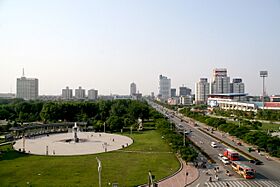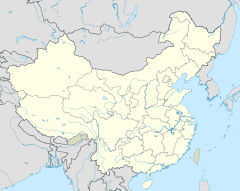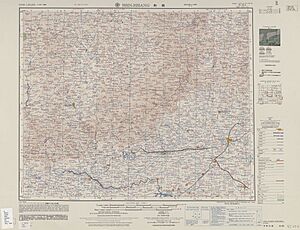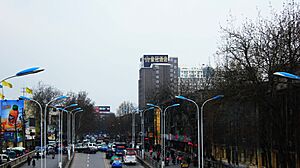Xinxiang facts for kids
Quick facts for kids
Xinxiang
新乡市
Sinsiang
|
|
|---|---|
|
Prefecture-level city
|
|
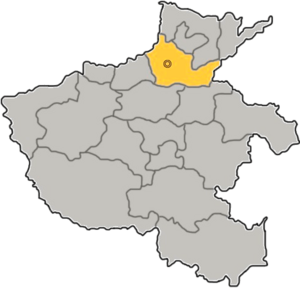
Xinxiang's location in Henan province
|
|
| Country | People's Republic of China |
| Province | Henan |
| Municipal seat | Hongqi District |
| Area | |
| • Prefecture-level city | 8,629 km2 (3,332 sq mi) |
| • Urban | 431 km2 (166 sq mi) |
| • Metro | 3,390 km2 (1,310 sq mi) |
| Population
(2020 census for total, 2018 otherwise)
|
|
| • Prefecture-level city | 6,251,929 |
| • Density | 724.53/km2 (1,876.51/sq mi) |
| • Urban | 1,179,400 |
| • Urban density | 2,736/km2 (7,087/sq mi) |
| • Metro | 2,743,200 |
| • Metro density | 809.2/km2 (2,095.8/sq mi) |
| GDP | |
| • Prefecture-level city | CN¥ 216.7 billion US$ 32.6 billion |
| • Per capita | CN¥ 37,805 US$ 5,692 |
| Time zone | UTC+8 (China Standard) |
| Area code(s) | 0373 |
| ISO 3166 code | CN-HA-07 |
| Major Nationalities | Han |
| County-level divisions | 12 |
| License plate prefixes | 豫G |
Xinxiang (simplified Chinese: 新乡; traditional Chinese: 新鄉; pinyin: Xīnxiāng) is a big city in northern Henan province, China. It's known as a prefecture-level city, which means it's a major city that also manages several smaller towns and counties around it.
Xinxiang is located near the provincial capital, Zhengzhou, and borders other cities like Kaifeng, Hebi, and Anyang. It also shares borders with the provinces of Shanxi and Shandong.
In 2020, over 6.2 million people lived in Xinxiang. A large part of this population, about 2.7 million people, live in the main city area. This area includes four urban districts and several nearby counties that are growing together.
Xinxiang is an important industrial city in northern Henan. It's a key stop on the Beijing–Guangzhou railway, a major train line. The city has a long history, with important events like the Battle of Mingtiao and the Battle of Muye happening here. Today, Xinxiang is recognized as a great tourist city, a healthy city, and a green city with many parks and forests.
Contents
History of Xinxiang
Xinxiang has a very old and interesting history. It was the place of the Battle of Muye, where the Shang dynasty was defeated by the armies of King Wu of Zhou. This battle was a big turning point in ancient Chinese history.
The name "Xinxiang" was first used in the year 586 AD during the Sui dynasty. This was when Xinxiang county was created. Later, in 960 AD, an important event called the Chenqiao Mutiny happened nearby. Soldiers loyal to Zhao Kuangyin rebelled and made him emperor, starting the Song dynasty.
From 1949 to 1952, Xinxiang was the capital of a short-lived province called Pingyuan. This province included several nearby cities. In July 2021, Xinxiang was affected by heavy flooding. This flood impacted many people and a large area of farmland.
In ancient times, during the periods of Emperor Yao and Emperor Shun, the area of Xinxiang belonged to different regions. The Battle of Mingtiao, which led to the end of the Xia Dynasty, also took place near what is now Xinxiang. During the Spring and Autumn period, the area was part of the state of Jin.
Over the centuries, the area saw many changes in its administration. Different counties were established and sometimes abolished. The name Xinxiang came from "Xinzhong Township" in Ji County, which was shortened.
Geography of Xinxiang
Xinxiang is located in the northern part of Henan Province. It's about 600 kilometers (370 miles) from China's capital, Beijing. It's also only about 80 kilometers (50 miles) from Zhengzhou, the capital of Henan province.
The city is connected to the oil city of Puyang in the east. To the west, it borders Jiaozuo and the province of Shanxi. The Yellow River forms its southern border, separating it from Zhengzhou and Kaifeng. To the north, Xinxiang is close to the Taihang Mountains and neighbors Hebi and Anyang.
Climate in Xinxiang
Xinxiang has a climate with four distinct seasons. Summers are hot and rainy, while winters are cold and dry. Spring and autumn are generally mild. The city gets most of its rain in July and August.
| Climate data for Xinxiang (1991–2020 normals, extremes 1981–2010) | |||||||||||||
|---|---|---|---|---|---|---|---|---|---|---|---|---|---|
| Month | Jan | Feb | Mar | Apr | May | Jun | Jul | Aug | Sep | Oct | Nov | Dec | Year |
| Record high °C (°F) | 18.9 (66.0) |
24.8 (76.6) |
29.0 (84.2) |
36.1 (97.0) |
38.0 (100.4) |
40.9 (105.6) |
40.5 (104.9) |
37.7 (99.9) |
36.8 (98.2) |
34.3 (93.7) |
27.7 (81.9) |
23.9 (75.0) |
40.9 (105.6) |
| Mean daily maximum °C (°F) | 5.5 (41.9) |
9.6 (49.3) |
15.5 (59.9) |
22.1 (71.8) |
27.4 (81.3) |
32.1 (89.8) |
32.1 (89.8) |
30.8 (87.4) |
27.0 (80.6) |
21.6 (70.9) |
13.8 (56.8) |
7.4 (45.3) |
20.4 (68.7) |
| Daily mean °C (°F) | 0.3 (32.5) |
3.9 (39.0) |
9.9 (49.8) |
16.3 (61.3) |
21.9 (71.4) |
26.5 (79.7) |
27.6 (81.7) |
26.3 (79.3) |
21.8 (71.2) |
15.8 (60.4) |
8.2 (46.8) |
2.2 (36.0) |
15.1 (59.1) |
| Mean daily minimum °C (°F) | −3.7 (25.3) |
−0.6 (30.9) |
4.8 (40.6) |
10.8 (51.4) |
16.5 (61.7) |
21.1 (70.0) |
23.7 (74.7) |
22.6 (72.7) |
17.5 (63.5) |
11.1 (52.0) |
3.8 (38.8) |
−1.9 (28.6) |
10.5 (50.8) |
| Record low °C (°F) | −13.9 (7.0) |
−16.0 (3.2) |
−6.2 (20.8) |
−0.7 (30.7) |
7.6 (45.7) |
12.4 (54.3) |
17.2 (63.0) |
13.5 (56.3) |
7.5 (45.5) |
−0.9 (30.4) |
−12.8 (9.0) |
−11.5 (11.3) |
−16.0 (3.2) |
| Average precipitation mm (inches) | 5.6 (0.22) |
8.8 (0.35) |
14.1 (0.56) |
31.1 (1.22) |
42.6 (1.68) |
66.4 (2.61) |
163.5 (6.44) |
120.2 (4.73) |
62.2 (2.45) |
29.1 (1.15) |
20.0 (0.79) |
4.7 (0.19) |
568.3 (22.39) |
| Average precipitation days (≥ 0.1 mm) | 2.6 | 3.7 | 3.9 | 5.1 | 6.5 | 7.6 | 11.1 | 10.1 | 7.5 | 5.8 | 4.5 | 2.3 | 70.7 |
| Average snowy days | 3.3 | 3.1 | 1.1 | 0.2 | 0 | 0 | 0 | 0 | 0 | 0 | 1.2 | 2.1 | 11 |
| Average relative humidity (%) | 59 | 57 | 55 | 59 | 60 | 61 | 76 | 78 | 73 | 68 | 67 | 61 | 65 |
| Mean monthly sunshine hours | 116.5 | 138.4 | 182.4 | 211.2 | 234.2 | 210.6 | 182.2 | 184.5 | 166.7 | 162.5 | 140.5 | 129.2 | 2,058.9 |
| Percent possible sunshine | 37 | 45 | 49 | 54 | 54 | 49 | 41 | 45 | 45 | 47 | 46 | 43 | 46 |
| Source: China Meteorological Administration | |||||||||||||
Air Quality in Xinxiang
Like many industrial cities, Xinxiang has faced challenges with air quality. Reports have shown that the city has higher levels of tiny particles in the air, known as PM2.5. These levels are sometimes above the safe limits set by the WHO.
Efforts are being made to improve air quality. The city is working to reduce pollution and make the air cleaner for everyone.
City Administration
Xinxiang is divided into different areas for easier management. It has 4 urban districts, 3 cities that are managed by the main city, and 5 counties.
- Districts:
- Weibin District
- Hongqi District
- Muye District
- Fengquan District
- County-level cities:
- Huixian City
- Weihui City
- Changyuan City
- Counties:
- Xinxiang County
- Huojia County
- Yuanyang County
- Yanjin County
- Fengqiu County
| Map |
|---|

Hongqi
Weibin
Fengquan
Muye
Xinxiang
County Huojia
County Yuanyang
County Yanjin
County Fengqiu
County Weihui
(city) Huixian
(city) Changyuan
(city) |
Population of Xinxiang
At the end of 2022, Xinxiang had a permanent population of about 6.16 million people. Most of these people, about 3.6 million, live in urban areas. The rest live in rural areas. The number of people living in urban areas is growing.
In 2020, a census showed that the city's population was 6,251,929. The number of males and females was almost equal.
The population is made up of people of all ages. About 23% of the population is aged 0-14 years old. About 59% are aged 15-59 years old. The remaining 17% are 60 years or older.
Many people in Xinxiang have a good education. For every 100,000 people, over 11,000 have a university degree. Many others have high school or secondary education.
Economy and Industries
Xinxiang is an important industrial city. It has many different businesses and factories.
One major company that used to be here was Frestech, a big home appliance company. Even though it closed, parts of it continued. Xinfei Electric Group, for example, still operates in Xinxiang. This company makes many things, including refrigerated trucks, military vehicles, and even parts for homes and offices. They also produce refrigerators and air conditioners.
Other important companies in Xinxiang include Golden Dragon Copper Group, Bailu Chemical Fibre, Henan Kelong Group, and AVIC XINHANG Industry Corporation.
Farming and Textiles
Farming and making textiles (like cloth and clothing) are also very important to Xinxiang's economy. The city has a long history in the cotton industry, which is well-developed here.
Transportation in Xinxiang
Xinxiang is a key transportation hub, especially for trains. It's located where several major railway lines meet. The Wei River also runs through the city. This river was improved in the 1950s to allow small boats to travel, connecting Xinxiang to Tianjin.
Railways
Xinxiang is a junction for several important railway lines:
- Beijing-Guangzhou Railway
- Xinxiang-Yueshan Railway
- Xinxiang-Yanzhou Railway
- Zhengzhou–Jinan high-speed railway
The city has two main train stations: Xinxiang Railway Station and Xinxiang East Railway Station.
Expressways
Several expressways pass through or near Xinxiang, making it easy to travel by car:
 G4 Beijing–Hong Kong and Macau Expressway
G4 Beijing–Hong Kong and Macau Expressway G3511 Heze–Baoji Expressway
G3511 Heze–Baoji Expressway G5512 Jincheng–Xinxiang Expressway
G5512 Jincheng–Xinxiang Expressway
National Highways
Education and Research
Xinxiang is a city that focuses on learning and research. It's recognized as one of the top 200 cities in the world for scientific research.
The city is home to several universities and colleges:
- Henan Normal University
- Xinxiang University: This university has many different departments and centers.
- Henan Institute of Science and Technology
- Xinxiang Medical University
- Henan Mechanical and Electrical Engineering College
- Xinxiang Hygiene School
Sister Cities
Xinxiang has special partnerships with cities in other countries. These are called "sister cities" and help promote friendship and cultural exchange.
 Itajaí, Santa Catarina, Brazil
Itajaí, Santa Catarina, Brazil Kashiwara, Osaka, Japan
Kashiwara, Osaka, Japan
See also
 In Spanish: Xinxiang para niños
In Spanish: Xinxiang para niños


